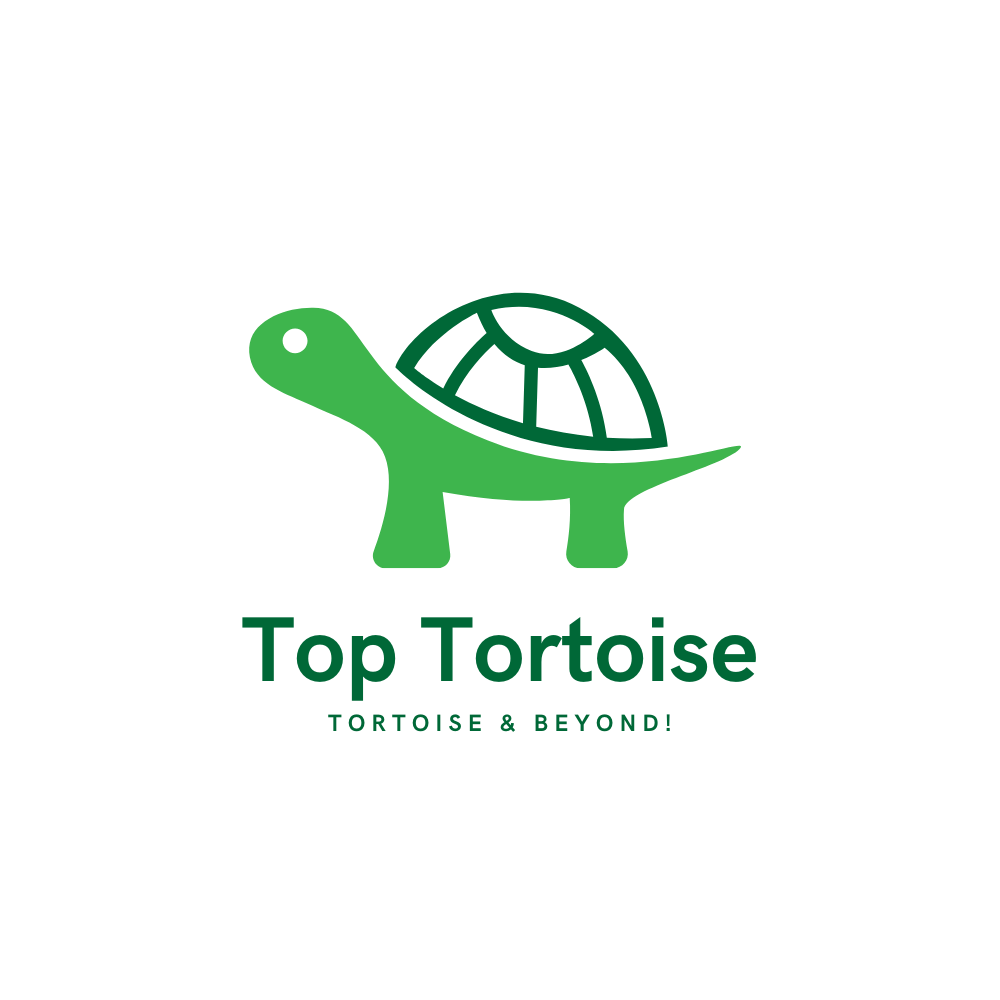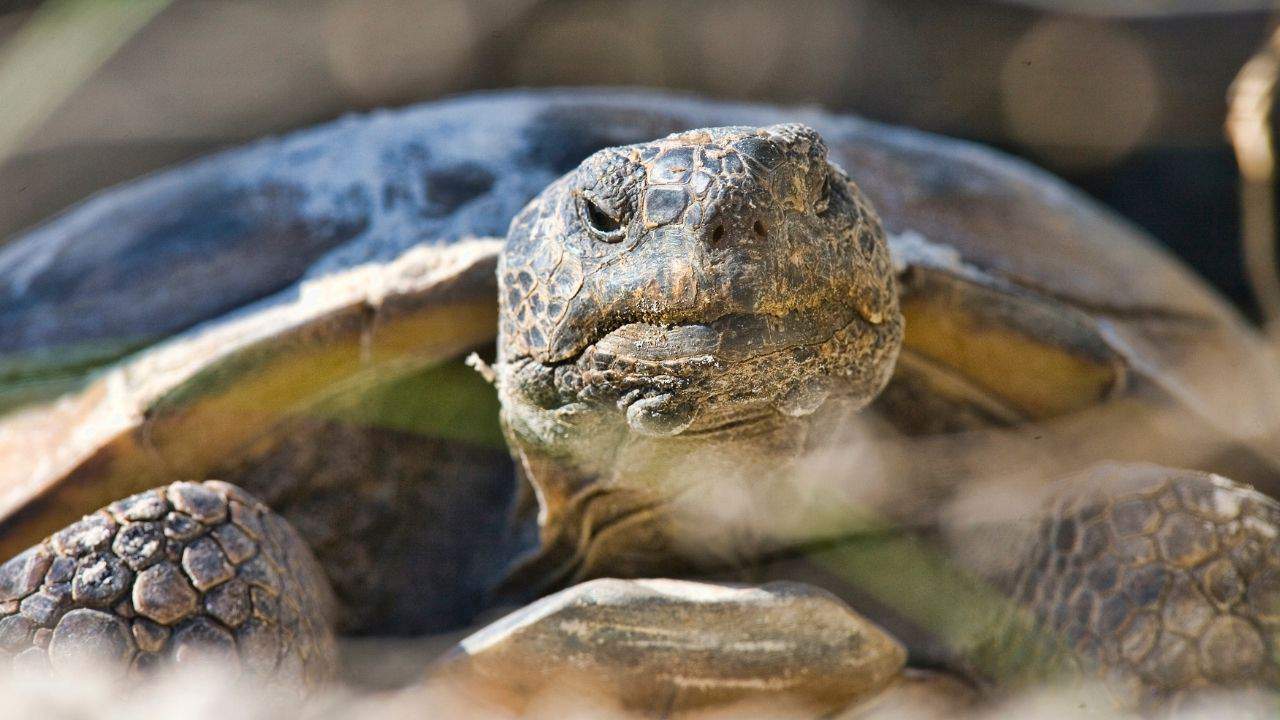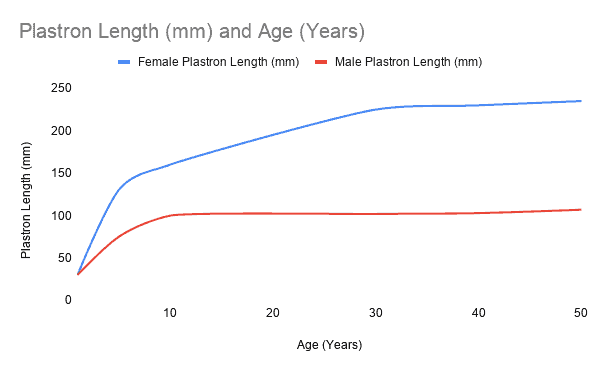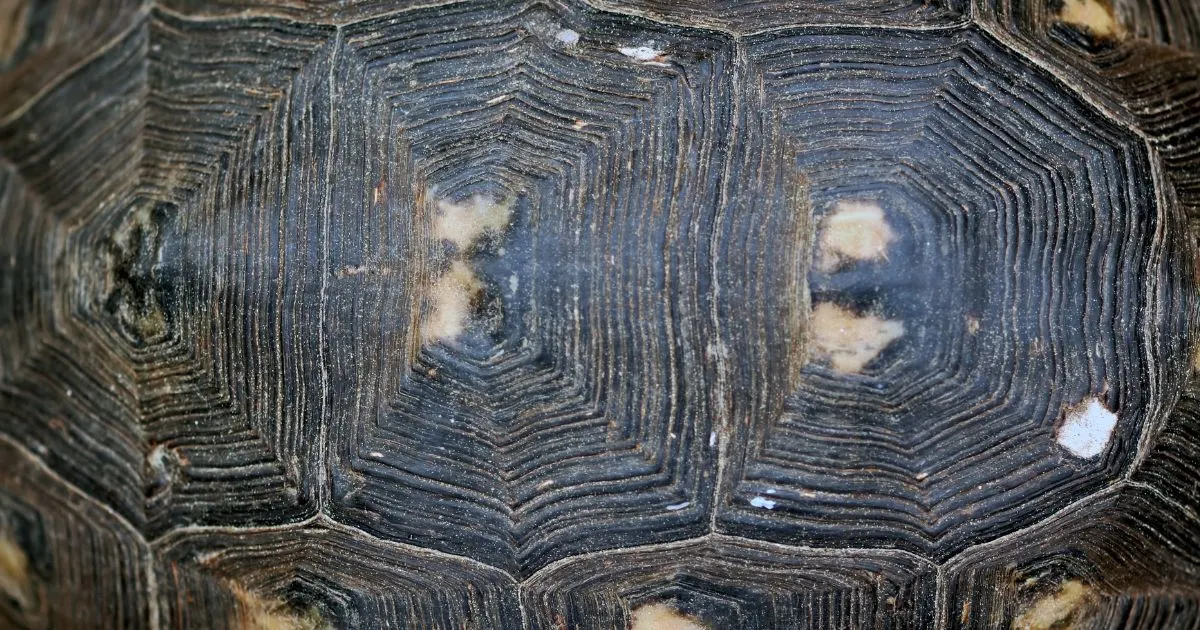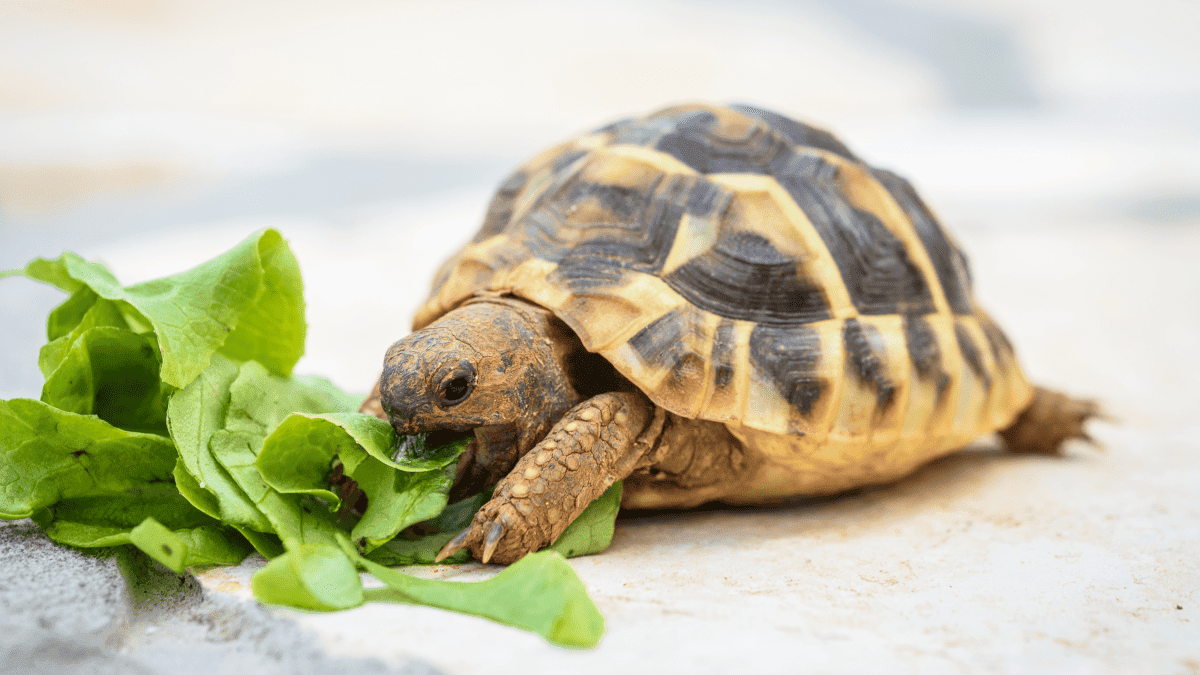How to tell the age of a tortoise? Determining the age of a tortoise can be challenging; however, examining growth rings on the shell, size, and general health can provide some indications.
Some Common Methods To Tell a Tortoise’s Age
“Counting Rings” Method:
- Understanding Scutes and Rings:
- Scutes are the scales covering a turtle’s carapace (upper shell), where rings develop.
- Rings form during periods of both proper feeding and scarcity of food, not just during summer and winter, providing a rough age estimate.
- Identifying Rings on Scutes:
- Rings alternate between wider and narrower sections on the scutes, sometimes with varying colors.
- Wider rings represent times of proper feeding (summer), while narrower rings signify scarcity (winter).
- A complete ring cycle (wide + narrow) represents a year; counting and dividing by 2 offers a rough age estimate.
- Carefully count the rings within the scutes, as they can be more visible in some turtle species.
- Calculating Age:
- After counting the rings, divide the total by 2 to estimate the turtle’s age.
- For example, if you count 14 rings, the turtle is roughly 7 years old.
- Note: Counting becomes challenging after 15 years as rings converge.
“Checking The Size” Method:
| Male Plastron Length (mm) | Female Plastron Length (mm) | Age (Years) |
|---|---|---|
| 30 to 40 | 30 to 40 | Newborn |
| Around 75 | Around 130 | 5 |
| Around 100 | Around 160 | 10 |
| A little above 100 | Around 225 | 30 |
| A little above 100 | Around 230 | 40 |
| A little above 100 | Around 235 | 50 |
- Size Assessment:
- Measure the turtle’s length from nose to tail using a measuring tape or ruler, primarily for matured turtles.
- For restless turtles, offer a tempting treat to keep them still during measurement.
- Reference Size Chart:
- Obtain a size chart specific to the turtle’s species from reliable sources online or in libraries.
- Note that turtles in captivity grow faster than those in the wild, potentially skewing age estimations.
- Comparing Length to Age:
- Compare the turtle’s length to the corresponding age on the size chart, especially if it hasn’t reached full length yet.
Note: Actual age determination may vary due to species-specific factors and growth rates influenced by captivity or wild conditions.
Visual Signs Of Age:
In the wild, some turtles exhibit visual indicators of aging, although these signs do not provide precise age information but help determine maturity. For instance, the condition and coloration of the shell reflect whether a turtle has reached adulthood.
Older turtles typically have worn and torn carapaces with dents and chips, while the plastron may remain smooth, and scars may appear on the head and legs. These signs suggest maturity, typically occurring between 10 to 20 years of age.
From Hatchling to Senior: Understanding the Life Stages of Your Tortoise
Tortoises, like many other animals, go through different life stages as they grow and develop. Understanding these life stages is crucial for providing proper care and management for these reptiles.
Each stage comes with its own unique characteristics, nutritional requirements, housing needs, and health concerns. By understanding the different life stages of tortoises, owners can ensure that they are providing the best possible care for their pets.
Hatchling Phase: The First Year of Life
The hatchling phase is the first year of a tortoise’s life. During this time, hatchlings are small and vulnerable, requiring special care and attention. They have distinct physical characteristics, such as a soft shell and a small size. Hatchlings are also very active and curious, exploring their surroundings and learning about their environment.
In terms of nutrition, hatchlings have specific dietary requirements. They need a diet that is high in protein to support their rapid growth. Feeding recommendations for hatchlings include a combination of commercial tortoise food, fresh vegetables, and occasional fruits. It is important to provide a varied diet to ensure that hatchlings receive all the necessary nutrients.
Housing and habitat requirements for hatchlings include a warm and humid environment with access to UVB lighting. They should be housed in a secure enclosure that protects them from predators and provides enough space for them to move around. It is also important to provide hiding spots and areas for basking.
Common health concerns for hatchlings include respiratory infections, shell deformities, and parasites. Regular veterinary check-ups are essential during this stage to monitor the health of the tortoise and address any potential issues.
Juvenile Phase: Growing Up and Developing
The juvenile phase is the period when tortoises are growing up and developing. During this stage, they undergo significant changes in their physical appearance and behavior. Juvenile tortoises start to develop their adult coloration and patterns, and their shells become harder and more defined.
In terms of nutrition, juvenile tortoises still require a diet that is high in protein to support their growth. Feeding recommendations include a combination of commercial tortoise food, fresh vegetables, and occasional fruits. It is important to provide a balanced diet that meets their nutritional needs.
Housing and habitat requirements for juvenile tortoises are similar to those of hatchlings. They need a warm and humid environment with access to UVB lighting. The enclosure should be spacious enough to allow for movement and exploration.
Common health concerns for juvenile tortoises include shell injuries, respiratory infections, and parasites. Regular veterinary check-ups are important during this stage to monitor the tortoise’s health and address any potential issues.
Sub-Adult Phase: Preparing for Adulthood
The sub-adult phase is the period when tortoises are preparing for adulthood. During this stage, they continue to grow and develop, but at a slower rate compared to the previous stages. Sub-adult tortoises start to exhibit more adult-like physical characteristics, such as a fully developed shell and coloration.
In terms of nutrition, sub-adult tortoises require a balanced diet that includes a variety of vegetables, fruits, and commercial tortoise food. It is important to provide a diet that meets their nutritional needs and promotes overall health.
Housing and habitat requirements for sub-adult tortoises are similar to those of hatchlings and juveniles. They need a warm and humid environment with access to UVB lighting. The enclosure should be spacious enough to allow for movement and exploration.
Common health concerns for sub-adult tortoises include shell injuries, respiratory infections, and parasites. Regular veterinary check-ups are important during this stage to monitor the tortoise’s health and address any potential issues.
Adult Phase: Maturity and Reproduction
The adult phase is the period when tortoises reach maturity and are capable of reproduction. Adult tortoises have fully developed physical characteristics, such as a hard shell and adult coloration. They also exhibit specific behaviors related to mating and reproduction.
In terms of nutrition, adult tortoises require a diet that is low in protein and high in fiber. Feeding recommendations include a variety of vegetables, fruits, and commercial tortoise food. It is important to provide a balanced diet that meets their nutritional needs and promotes overall health.
Housing and habitat requirements for adult tortoises are similar to those of the previous stages. They need a warm and humid environment with access to UVB lighting. The enclosure should be spacious enough to allow for movement and exploration.
Common health concerns for adult tortoises include respiratory infections, shell injuries, and reproductive issues. Regular veterinary check-ups are important during this stage to monitor the tortoise’s health and address any potential issues.
Senior Phase: Aging and Health Concerns
The senior phase is the period when tortoises start to age and may experience health concerns associated with old age. Senior tortoises may exhibit physical changes, such as a decrease in activity level and changes in appetite. They may also be more susceptible to certain health conditions.
In terms of nutrition, senior tortoises require a diet that is low in protein and high in fiber. Feeding recommendations include a variety of vegetables, fruits, and commercial tortoise food. It is important to provide a balanced diet that meets their nutritional needs and promotes overall health.
Housing and habitat requirements for senior tortoises are similar to those of the previous stages. They need a warm and humid environment with access to UVB lighting. The enclosure should be spacious enough to allow for movement and exploration.
Common health concerns for senior tortoises include respiratory infections, shell injuries, arthritis, and organ failure. Regular veterinary check-ups are important during this stage to monitor the tortoise’s health and address any potential issues.
Factors Affecting Tortoise Life Expectancy
Several factors can impact the life expectancy of tortoises. Environmental factors, such as temperature, humidity, and access to sunlight, play a crucial role in their overall health and well-being. Tortoises require specific environmental conditions to thrive and live a long and healthy life.
Genetic factors can also impact tortoise lifespan. Some species of tortoises have longer lifespans than others, and individual tortoises within a species may have genetic predispositions to certain health conditions. It is important to research the specific needs and characteristics of the tortoise species you own to provide appropriate care.
Proper care and management are essential for maximizing the lifespan of tortoises. This includes providing a balanced diet, a suitable habitat, regular veterinary check-ups, and addressing any health concerns promptly. By providing the best possible care, owners can help their tortoises live a long and healthy life.
Understanding Tortoise Behavior in Different Life Stages
Understanding tortoise behavior is crucial for providing proper care and management at each life stage. Tortoises exhibit different behaviors depending on their age and developmental stage. By understanding these behaviors, owners can ensure that their tortoises are happy and healthy.
Hatchlings are typically very active and curious, exploring their surroundings and learning about their environment. They may exhibit behaviors such as digging, climbing, and basking in the sun. It is important to provide a safe and stimulating environment for hatchlings to encourage natural behaviors.
Juvenile tortoises may become more territorial and may exhibit aggressive behaviors towards other tortoises or animals in their enclosure. They may also start to establish their own territories within the enclosure. Providing enough space and hiding spots can help reduce stress and aggression in juvenile tortoises.
Adult tortoises may exhibit mating behaviors, such as courtship displays and aggression towards potential mates. It is important to provide appropriate opportunities for mating and to monitor the behavior of adult tortoises to ensure their well-being.
Nutrition and Diet for Tortoises at Different Life Stages
Proper nutrition is essential for the overall health and longevity of tortoises. The nutritional requirements of tortoises vary depending on their life stage. It is important to provide a balanced diet that meets their specific needs at each stage.
Hatchlings require a diet that is high in protein to support their rapid growth. Feeding recommendations include a combination of commercial tortoise food, fresh vegetables, and occasional fruits. It is important to provide a varied diet to ensure that hatchlings receive all the necessary nutrients.
Juvenile tortoises still require a diet that is high in protein to support their growth, but the amount of protein can be gradually reduced as they get older. Feeding recommendations include a combination of commercial tortoise food, fresh vegetables, and occasional fruits. It is important to provide a balanced diet that meets their nutritional needs.
Sub-adult and adult tortoises require a diet that is low in protein and high in fiber. Feeding recommendations include a variety of vegetables, fruits, and commercial tortoise food. It is important to provide a balanced diet that meets their nutritional needs and promotes overall health.
Housing and Habitat Requirements for Tortoises in Different Life Stages
Providing appropriate housing and habitat for tortoises is crucial for their overall health and well-being. The housing and habitat requirements of tortoises vary depending on their life stage.
Hatchlings require a warm and humid environment with access to UVB lighting. They should be housed in a secure enclosure that protects them from predators and provides enough space for them to move around. It is also important to provide hiding spots and areas for basking.
Juvenile tortoises have similar housing and habitat requirements as hatchlings. They need a warm and humid environment with access to UVB lighting. The enclosure should be spacious enough to allow for movement and exploration.
Sub-adult and adult tortoises also require a warm and humid environment with access to UVB lighting. The enclosure should be spacious enough to allow for movement and exploration. It is important to provide hiding spots, areas for basking, and opportunities for exercise.
Health and Veterinary Care for Tortoises in Different Life Stages
Regular veterinary care is essential for the health and well-being of tortoises at every life stage. It is important to schedule regular check-ups with a reptile veterinarian to monitor the health of the tortoise and address any potential issues.
Common health concerns for tortoises include respiratory infections, shell injuries, parasites, and reproductive issues. Regular veterinary check-ups can help identify these issues early on and provide appropriate treatment.
In addition to regular check-ups, owners should also be proactive in providing preventative care for their tortoises. This includes maintaining proper hygiene in the enclosure, providing a balanced diet, and monitoring the tortoise’s behavior and overall well-being.
Conclusion:
Understanding the different life stages of tortoises is crucial for providing proper care and management. Each life stage comes with its own unique characteristics, nutritional requirements, housing needs, and health concerns. By understanding these stages, owners can ensure that they are providing the best possible care for their tortoises.
Proper nutrition, housing, and veterinary care are essential for maximizing the lifespan and well-being of tortoises. It is important to provide a balanced diet that meets their specific nutritional needs at each life stage. Housing should be appropriate for their size and provide a suitable environment for them to thrive. Regular veterinary check-ups can help monitor their health and address any potential issues.
By providing the best possible care and management, owners can help their tortoises live long and healthy lives. Understanding the unique needs and behaviors of tortoises at each life stage is key to providing the best care and ensuring their overall well-being.
Originally posted 2024-02-01 09:47:24.
